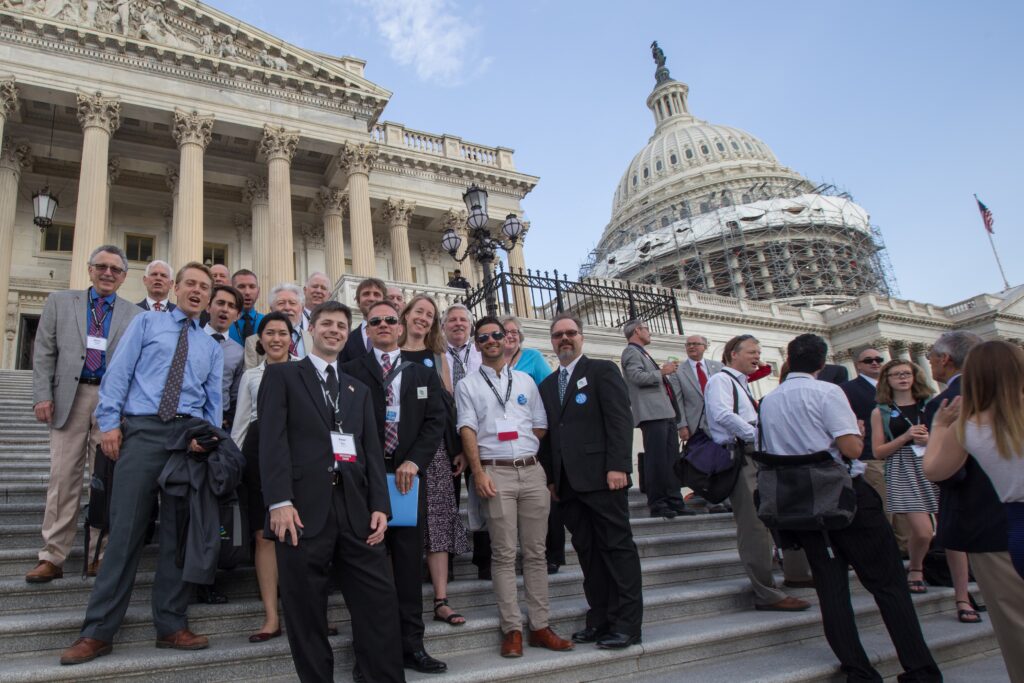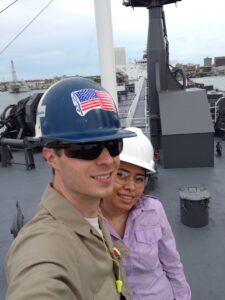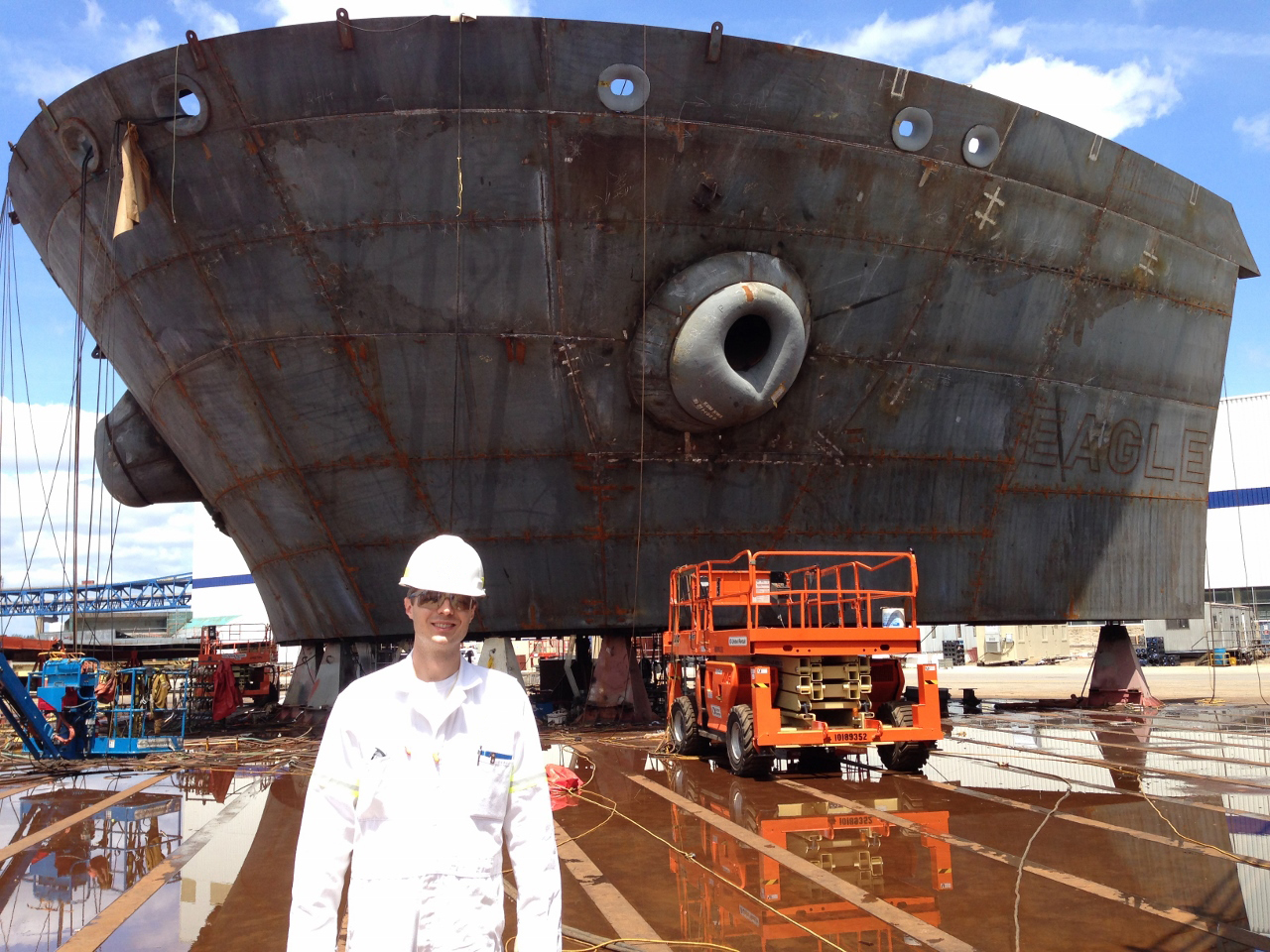As we celebrate Earth Day on April 22nd, we are thrilled to have Peter Bryn, a climate change expert and advocate, shed light on the critical role of sustainability in the shipping industry. The shipping industry is a global player in driving international trade and is responsible for transporting 90% of world trade. It also contributes to environmental challenges such as pollution and greenhouse gas emissions. Peter (Webb ’06) conveys the responsibility of maritime-focused engineering institutions like Webb in fostering this change.
Peter devoted his career to championing environmentalism and sustainability in the shipping industry. He has testified before Congress on zero-emission shipping and is currently spearheading Eolic Green Ammonia, harnessing renewable resources to create a more sustainable future. He previously worked for MAE Energy, ABB Marine & Ports, Citizen’s Climate Lobby, and ExxonMobil.
Peter encourages us to think forward and ensure that the next generation of Webbies and engineers contribute to a greener future for all.

Toward Sustainability: Peter and his colleagues champion green initiatives on the steps of Capitol Hill in Washington DC.
What inspired your interest in sustainability (especially in the shipping industry), and how important is this sector right now as more and more companies talk about ESG – Environmental, Social and Governance?
Sustainability has always been with me, though my interests have evolved. When I was younger, I had an empathic urge to care for “the environment” which I saw as being unable to defend itself.
That inclination turned into a mission and passion in grad school when I gained a much deeper awareness of climate change. Once you know it, you can’t unknow it. I decided at that time my life’s personal and professional focus would be on climate.
That focus has strengthened as I’ve gained a greater appreciation and understanding of the complexity, diversity, interconnectedness, and usefulness of the ecosystems on our planet, both for their own sake and because I realize how much our own survival depends on it.
As for applying my climate focus to the maritime industry, that’s both interest and pragmatism. Interest because I have a passion for the industry, and pragmatism because it is a place where I can add the most value.
What role did Webb play in motivating you to take on the role(s) that you have had in addressing sustainability in transportation?
When I was at Webb, I was the “green guy” in the school, but I’m not sure many others shared that passion. I’m pleased to see a growing interest in this topic at Webb.
My time at Webb didn’t directly impact my sustainability mindset. But Webb did prepare and position me with the tools and connections needed to have a successful career in which I could make sustainability the focus.
A Webb transcript, Webb professional connection, and Webb alum-turned-MIT-professor facilitated my path to MIT for grad school. After MIT and with a freshly formed decision to focus on climate and energy, another Webb connection helped start my career with ExxonMobil.
Fifteen years on I continue to find opportunities where my Webb network, education, and connections still help me on a regular basis. Just today I developed a basic heat balance model on which I’m sure Professor Wiggins would leave lot of green ink on if he saw it, but it was good enough for the ballpark estimates we needed!

Testifying before Congress: Peter testified on climate change and what the federal government can do to invest in zero-emissions technologies for the marine industry.
We hear all the time about the importance of reducing our carbon footprint; what exactly is carbon? How much carbon is the shipping industry producing, and what can we do to help mitigate this impact?
Most of us learned about the greenhouse effect in grade school, where carbon dioxide (CO2) and other gases in the atmosphere effectively capture radiant heat waves rather than allowing them to escape back out into space, thereby keeping the planet habitable. Adding a Webb-level spin to it, I analogize CO2’s behavior to Differential Equations where certain light wavelengths in the visible spectrum excite different natural frequencies of a CO2 molecule thereby capturing the energy.
It’s easy to take a stable climate for granted since it’s all humanity has ever known. But you don’t have to look far back into Earth’s history or out to other planets (think of frozen Mars with little atmosphere or sweltering Venus with runaway greenhouse gases) to realize how precious and fragile our climate is. And now for over a century human activity has been actively destabilizing this delicate balance as we extract gigatons of stable carbon chains from underground, burn them, and release the resulting CO2 into the atmosphere.
Shipping is estimated to contribute 3% to global CO2 emissions. The United Nations delegated responsibility for marine greenhouse gases (GHG) to the International Maritime Organization (IMO) which took its boldest step in 2018 by setting industry goals: reductions of 40% and 70% of CO2 per transport work by 2030 and 2050, respectively, and a 50% reduction in total annual emissions of GHG by 2050. Discussions continue on even tighter goals for 2050.
My inner climate advocate knows that policy is moving intolerably slow; these changes should have started forty years ago. And yet, as an industry professional I’m both shocked and ecstatic at how lightning-fast things are moving relative to what we usually expect.
What can each Webbie do? As an individual, tell your members of Congress to support strong climate policy including carbon pricing. As a maritime professional, get smarter and become champions for implementing ammonia, battery electrification, and other zero-emission alternative fuels.

In Chile: Captured at Cerro Domindor Solar Thermal Plant.
What is green ammonia, and what led you to establish a company focused on sustainable fuel?
Green ammonia is ammonia made from renewable energy. A “rainbow” of colors is emerging to describe different hydrogen production pathways – “gray ammonia” referring to traditional ammonia produced from natural gas (highly carbon intensive), “blue” from natural gas but with carbon sequestration, and “pink” from nuclear.
Once the power has been sourced, the only other “ingredients” for green ammonia are hydrogen (generated via the electrolysis of water) and nitrogen (separated from the air). A more detailed explanation is available on our website.
My migration into green ammonia production was a three-step process.
First, after long considering how to decarbonize oceangoing vessels, I was excited that the industry seriously tackled this question in the past five years. Investigating the handful of proposed fuels including ammonia, I coupled what I was reading with my understanding of vessel operations, economic drivers, and the physics and thermodynamics of production (thanks Webb!) and I became convinced that ammonia will prevail for marine in a decarbonized world.
Second, I stumbled upon a Houston-led, Chilean-based green ammonia startup, which allowed me to see a real green ammonia developer in action. I had several takeaways from that experience but perhaps most important was meeting the founder, a serial entrepreneur who created several impressive large industrial companies in a variety of industries, which inspired me to ask, “why not me?” While it was a great company and team, it was not the right fit, and we parted ways back in August.
Third, the USA’s Inflation Reduction Act was passed which created a massive tax incentive for US projects to create green hydrogen. That legislation turned the attention of the world from the areas that have been hotbeds for green ammonia production – Australia, Namibia, Oman, Saudi, Egypt, Chile – to the USA.
So, I started Eolic in August and we (now a team of four) have been making great progress since.

Picture Perfect: Peter shares a heartwarming moment with his partner/ girlfriend, Sandy, atop a ship, showcasing the fruits of his labor in the pursuit of a greener and more sustainable future.
How impactful do you think engineering colleges like Webb play in educating the next generation of professionals toward greater sustainability and environmental responsibility?
It’s been remarkable to watch solar, wind, electric vehicles (EV’s), batteries, and hopefully now hydrogen move from niche to mainstream to often becoming the cheapest energy option available. How this happened has revealed a “chicken and egg” trend each time between policy and technology.
On the one hand, policy is needed to help bring new technology to market at scale, since that’s where the cost savings emerge. This is an exercise of democratic action that happens when politicians hear from their constituents. In this sense, I’d urge Webbies and all engineers to remember their power as citizen advocates by calling on their elected representatives to support strong climate policy.
On the other hand, politicians more readily support new policy when solutions become “real.” It’s far easier to pass an EV mandate once EV’s are already being adopted and are proving to be better and cheaper. Scientists, engineers, and entrepreneurs must be ambassadors to bring new clean tech solutions to market. Once people see clean tech in action, and saving them money, they become natural advocates.
What advice do you have for Webb students on life after graduation?
These may not be remarkable, and some are cliché, but hopefully all are useful:
- Live for something greater than yourself.
- Be a generous listener; be humble.
- Don’t burn bridges.
- Be proactive, but don’t always be looking for your next job. Instead, focus on doing great work and increasing your value, and opportunities will emerge.
- Don’t be afraid to try new things, but always try to find ways to leverage past skillsets. Synergies will naturally surface.
- Build and leverage your network – LinkedIn is a fantastic tool.
- Take risks, but calculated ones.
- Think critically.
- Try to be observant and learn to read people.
- Don’t be naive but give folks the benefit of the doubt that they’re acting in good faith.
And most important of all, donate back to Webb!

Standing Humbly: Peter poses in front of a colossal ship, symbolizing the power of human innovation and the huge impact on the maritime industry.

